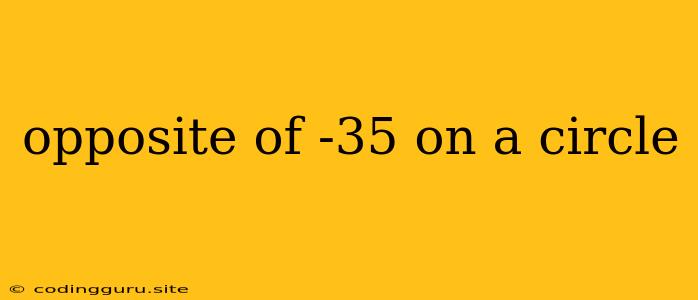What is the Opposite of -35 on a Circle?
Understanding opposites on a circle might seem confusing at first, but it's a fundamental concept in trigonometry and geometry. This concept is essential for understanding angles, radians, and the relationship between points on a circle.
Let's break it down step by step:
Circles and Opposites
Imagine a circle with its center at the origin of a coordinate plane (0,0). The circle's circumference is divided into 360 degrees, with 0 degrees starting at the point where the circle intersects the positive x-axis.
The key to understanding opposites on a circle is that they lie directly across the circle's diameter from each other.
Think of it like this:
- -35 degrees: This is a point on the circle in the fourth quadrant (the bottom right part of the circle)
- Opposite of -35 degrees: This is the point on the circle that is 180 degrees away from -35 degrees.
Finding the Opposite
To find the opposite of -35 degrees on a circle, you need to add 180 degrees:
- -35 degrees + 180 degrees = 145 degrees
Therefore, the opposite of -35 degrees on a circle is 145 degrees.
Visualizing the Opposite
Imagine a line segment drawn from the center of the circle through -35 degrees and extending to the other side of the circle. The point where this line segment intersects the circle is the opposite of -35 degrees, which is 145 degrees.
Applications of Opposites on a Circle
Understanding opposites on a circle is crucial in various applications, including:
- Trigonometry: Trigonometric functions like sine, cosine, and tangent use angles measured on a circle. Knowing the opposite of an angle helps determine the relationships between these functions for different angles.
- Navigation: Opposites on a circle are used in navigation to determine bearing and direction.
- Engineering: Understanding opposites is important in engineering applications like designing circular structures and rotating machinery.
Key Points to Remember
- Opposites on a circle lie 180 degrees apart from each other.
- The opposite of an angle is found by adding 180 degrees to the original angle.
- Opposites on a circle are crucial for understanding angles, radians, and trigonometric functions.
Conclusion
Finding the opposite of -35 degrees on a circle is a simple yet fundamental concept. By adding 180 degrees to the original angle, we can locate the opposite point on the circle's circumference. Understanding this concept is crucial for comprehending trigonometric relationships and various applications involving circular geometry.
